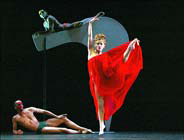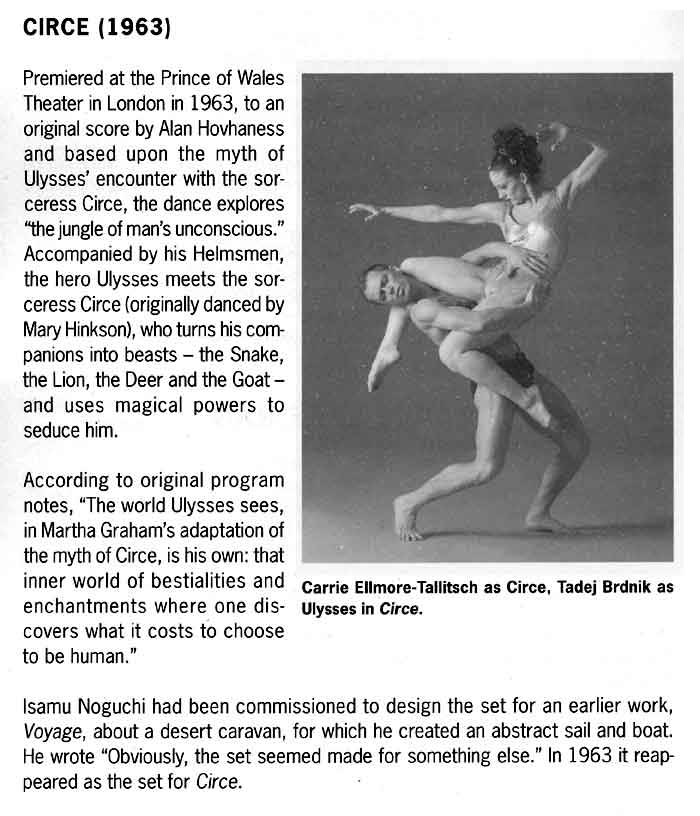

 |
 |
 |
| $35 for a spur of the moment whim (I saw the newspaper review at 5pm & caught the show at 8) – but worth every penny. No onstage morphing of course, and nothing beyond some face paint in the way of make-up. In fact, the 4 male dancers playing the animals (lion, snake, goat and deer) only wore bikini briefs in addition to their face paint. If you’re nervous watching nearly naked men writhing all over one another, this was not the dance performance for you to see. The feeling of them as animals was communicated in their dancing and body language of course – in essence, they were simultaneously both animal and human. The niftiest thing about this piece was Ulysses’ eagerness to become one of Circe’s pets, with the ‘animals’ welcoming him into their fold. Circe was perfect too, viewing the spectacle with an amused, knowing smile and seductively angled eyebrows. She wore yellow-gold bathing suit-style tights and a curving tiara in her hair. At one point she donned a long, sheer red cape, the better to tease Ulysses and the animals. (After she discarded it they took turns caressing themselves with it.) Seeing her gently petting the head of the blissed-out ‘lion’ resting in her lap, or the ‘snake’ wrapping himself around Ulysses were moments worthy of the Funhouse. Under the influence of Circe and the animals, Ulysses begins acting as bestial as them – it was easy to imagine him morphing into an animal form at that point. Unfortunately, his ‘helmsman’ –who’d been watching the revelry without taking part - rescues him & the two depart Circe’s island. (It looked an awful lot like the helmsman was jealous of the goings-on & afraid he’d lose his boyfriend to his new animal buddies, never mind Circe.) Music (by Alan Hovhaness) was excellent, too – mysterious, hypnotic, & mostly in the minor key to add to its overall spookiness – I’m definitely going to be looking for a recording of it. I almost forgot: a second dance on the program was Errand Into the Maze, based on the legend of the Minotaur. This version of the legend featured a woman instead of Theseus, who successfully tames the beast. The dancer wore an interesting set of horns on his head, which he seemed to be bracing in his teeth via a clamp connected to the horns. Here are two reviews of the performance FYI:
Terrifying Transformation: Martha Graham once wrote Jerome Robbins that he, like her, could surely liken artistic creation to the plight of Odin in the Icelandic sagas, who hung for nine nights upon a tree and then began to thrive. In two superb duets, Hérodiade (1944) and Errand into the Maze (1947), that grace her company's program B, a woman artist struggles to conquer her fears... ...In Errand's Jungian labyrinth, the dark places of the heroine's soul are embodied by a crude bull-man—horned, but hampered by a yoke that immobilizes his arms. Elizabeth Auclair gives a fascinating reading of the quester—seeming to hear or scent the presence of her oppressor (the excellent Martin Lofsnes), almost melting when she thinks she may have vanquished him. Auclair doesn't yet fully realize those moments before an inner change occurs, but she is a greatly gifted performer. Graham hoarded her own roles and often discarded those she could no longer dance. Terese Capucilli and Christine Dakin, the two splendid dancers who direct the company, wisely share the wealth. Circe doesn't involve a role Graham made for herself. The 1963 piece showed off Mary Hinkson, Bertram Ross, and some splendid young men. The choreography for them is the most exciting thing about this less than major work, and Lofsnes, Whitney Hunter, Christophe Jeannot, and Maurizio Nardi are terrific as Circe's erotic zoo of men-into-beasts (snake, lion, deer, and goat). Graham's Ulysses (Kenneth Topping) doesn't stoically resist the lure of Virginie Mécène's sorceress-as-autocratic-kitten; he wants to explore being a reveling beast. His conscience, as well as his stalwart helmsman (David Zurak—fine performances by both men), draw him back on course. Opening the Psyche and Finding Bulls and Other Beasts By ANNA KISSELGOFF The New York Times - April 17, 2004 http://www.nytimes.com/2004/04/17/arts/dance/17CIRC.html For Martha Graham, mythology was the psychology of the ancients. Never content to retell a tale, she had the genius to translate myth into an exploration of the modern psyche. As the Martha Graham Dance Company moved into higher gear on Thursday night for its second program at City Center, it was easy to see why Graham's myth-inspired works have a universal resonance. Repeatedly, as this program showed, the original tale becomes a metaphor for confronting eternal emotions, often those we hide from ourselves. A revival of "Circe" (1963) had Ulysses battling his baser instincts, embodied by beasts that the sorceress Circe treats here like pets. "Errand Into the Maze" and "Hérodiade," two of Graham's greatest works, have nameless heroines and operate on a loftier level. In "Errand" (1947), the woman is Ariadne and Theseus rolled into one, throwing off a bull-like man who evokes both the Minotaur and an abstract creature of fear ... Elizabeth Auclair, battling fear, especially sexual fear, has improved impressively since last year, giving a more complete and strongly danced portrayal as the heroine. Gian Carlo Menotti's melodramatic score and Noguchi's sexually explicit set complete the stage picture. At this performance, Martin Lofsnes was the lumbering bull. Unlike some in the role, he did not go berserk but sustained a relentless menace in his three encounters with Ms. Auclair... Graham did not cast herself at the center of "Circe," which she created for other company members. There is in fact no central figure but there is a ruling image of Ulysses and his helmsman on a Noguchi boat, which was sustained by Kenneth Topping and David Zurak. But the purring steaminess of the piece was missing in Virginie Mécène's baby-doll Circe. Each beast, however, had a star turn. Mr. Lofsnes was the snake, Whitney Hunter was the lion, Christophe Jeannot was the deer and, best of all, Maurizio Nardi was the goat. |